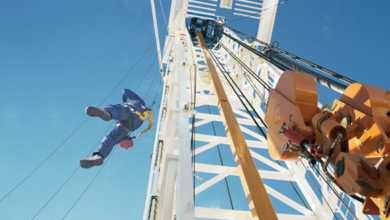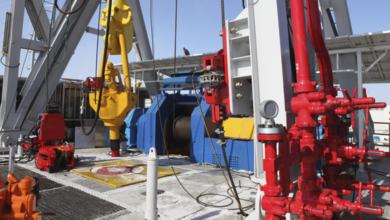D&C Tech Digest
Shell: Perdido installation opens new frontier for global oil/gas production
At its Perdido Development, Shell recently completed the installation of the drilling and production platform atop a 555-ft cylindrical spar floating in about 8,000 ft of water 200 miles from Houston in an isolated sector of the Gulf of Mexico. It is the deepest such facility in the world.
“Perdido is a technological tour de force that is opening up a new frontier for global oil and gas production,” said Russ Ford, Shell’s technology vice president for the Americas.
“Producing oil safely and responsibly this far out and this deep should allay concerns about industry access to the 85% of the US Outer Continental Shelf that remains undeveloped,” he added.
The Perdido project, which Shell operates on behalf of partners BP and Chevron, began with a lease sale in 1996. Several technologies had to be pioneered before commercial development could be launched in 2006.
Over the next several months, approximately 270 personnel living on the platform and on a “flotel” alongside it will complete the myriad of tasks in the commissioning and hookup required to produce first oil. The facility is capable of handling 130,000 bbl/day of oil equivalent. To get the oil and gas to market required installing 77 miles of oil export pipelines and 107 miles of gas export pipelines in a remote part of the Gulf of Mexico over very rugged sea floor terrain to connect to the existing offshore pipeline infrastructure.
Nine polyester mooring lines averaging more than two miles in length now hold the 50,000-ton floating structure in place, which will be nearly as tall as the Eiffel Tower when fully operational.
The Perdido Development includes a common processing hub that incorporates drilling capability and functionality to gather, process and export production within a 30-mile radius of the facility. This concept will provide regional synergies, reduced cost and lower risk, as well as reduce the number and size of the facilities and operations in this frontier area, resulting in a lower environmental impact than would otherwise be achieved.
100-level 3D, walkaway VSPs completed in Oman
Baker Hughes has successfully completed a seismic project in Oman, deploying a 100-level seismic tool array – the first of its kind in the world. The Baker Atlas Borehole Streamer Seismic Digital Array System was deployed to record two walkaway lines, which were each 5-mile long. The system enables large 3D VSP and walkaway VSP for customers with minimal rig time. Over 64,000 source receiver pairs for the walkaway VSP survey were recorded, with a total operating time of 65 hours.
Aker ready to field-test bidirectional tractor
Aker Solutions is very close to identifying a test well and operator for the first field trials of what it calls the world’s first bidirectional tractor. At press time, the company planned to test the tractor onshore by early May.
The PowerTrac Advance 434 Open Hole Tractor’s bidirectional capability means the tool can push heavier open tools into the well and to help retrieving tools by reversing the tool, according to the company.
“The reason the tools need assistance getting out of the hole is the strength limits on the cable,” said Oddvar Dalane, area manager for Aker Well Service.
Another advantage, he said, is that the tractor can be reversed if the open-hole tools become differentially stuck. The bidirectionality also helps if the cable becomes stuck against the well wall, he added.
The tractor features titanium drive sections, 4.75-in. wheels and 4.75-in. tool OD. It’s 21-ft long and can operate in temperatures up to 350°F.



